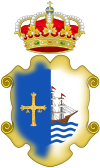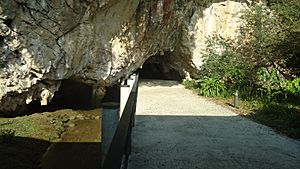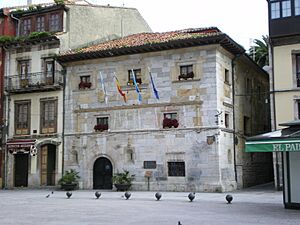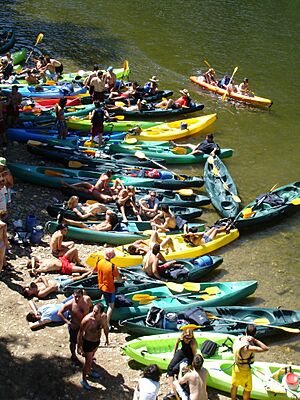Ribadesella facts for kids
Quick facts for kids
Ribadesella
|
|||
|---|---|---|---|
 |
|||
|
|||
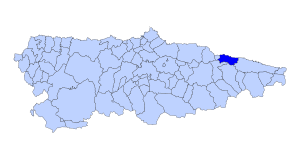
Location of Ribadesella
|
|||
| Country | |||
| Autonomous community | |||
| Province | Asturias | ||
| Comarca | Oriente | ||
| Capital | Ribadesella | ||
| Area | |||
| • Total | 84.37 km2 (32.58 sq mi) | ||
| Elevation | 897 m (2,943 ft) | ||
| Population | |||
| • Total | 5,730 | ||
| • Density | 67.92/km2 (175.90/sq mi) | ||
| Demonym(s) | riosellano | ||
| Time zone | UTC+1 (CET) | ||
| • Summer (DST) | UTC+2 (CEST) | ||
| Postal code |
33560
|
||
| Official language(s) | Asturian | ||
Ribadesella (called Ribeseya in Asturian) is a small town in the Asturias region of Spain. It covers about 84 square kilometers (32 square miles). The town is located on the Cantabrian Sea coast, where the River Sella meets the ocean. It is also close to the Picos de Europa mountains.
Ribadesella shares borders with other towns: Llanes to the east, Cangas de Onís and Parres to the south, and Caravia to the west. This town is also known as the hometown of Queen Letizia of Spain.
Every year, on the first weekend of August, a big event called the International Sella River Descent takes place here. Kayakers from all over the world come to race down the last 20 kilometers (12 miles) of the Sella River.
The town is also famous for its ancient Tito Bustillo Cave. This cave has amazing prehistoric paintings and is open for visitors all year. People often visit Ribadesella to enjoy its history, try out sports, see beautiful scenery, and taste local food.
Contents
Exploring Ribadesella's Past
Ribadesella has a very long history. One of its most important historical sites is the Tito Bustillo Cave. This cave is famous for its ancient wall paintings of animals and human figures. These paintings are thought to be about 29,000 years old, from a time called the Magdalenian age.
The Tito Bustillo Cave is so important that it is part of a UNESCO World Heritage Site. This site is called Paleolithic Cave Art of Northern Spain.
The first written records about Ribadesella are much more recent. They come from a Greek geographer named Strabo, who wrote about the area in the first century BC. He mentioned a river called "Noega" that separated two groups of people, the Astures and the Cantabrians. At that time, the people living in Ribadesella were called the Salaeni. They controlled a large area, including the towns of Colunga, Arriondas, and Llanes.
Discovering the Town of Ribadesella
Ribadesella has two main streets that are important for daily life. These are the Gran Vía de Agustin Argüelles and the Calle Comercio. Along these streets, you can find banks, pharmacies, restaurants, shops, and places to buy newspapers.
This area also includes the Casco Antiguo, which is the old part of town. Here, you will find the historic plaza and Ribadesella's main church, the Iglesia Parroquial de Sta. María Magdalena. The old town also has small shops selling local handmade products and many homes where people live.
A third important part of Ribadesella is the Paseo Marítimo del Puerto. This is a lovely walk along the port, where you can enjoy views of the sea and the boats.
Local Areas: Parishes of Ribadesella
The municipality of Ribadesella is divided into several smaller areas called parishes. Each parish has its own unique character. The capital of the municipality is also called Ribadesella.
Here are the parishes that make up Ribadesella:
- Berbes
- Collera
- Xuncu
- Leces
- Linares
- Moro
- Ribadesella (Capital)
- Santianes
- Ucio
Exciting Cultural Events
Ribadesella is famous for its lively cultural events and festivals. These events often include traditional food, music, and dancing. You can hear original Asturian bagpipe music and see people wearing traditional clothes.
The International Sella River Descent
The International Sella River Descent is a very popular race that happens every year. It takes place on the first weekend of August along the River Sella. This event is also known as "La Fiesta de Les Piragües" (The Festival of Canoes). People celebrate in the streets and plazas of Ribadesella. The race starts in Arriondas and finishes right in the center of Ribadesella, at the end of the Sella River.
Other Local Festivals
Many other festivals are celebrated in Ribadesella throughout the year. These often honor religious figures and include special traditions. Some of these celebrations are for:
- San Antón de Cuerres
- San José de Sebreñu
- Nuestra Señora de Fátima de Toriellu
- San Isidro
- San Lorenzo
- Nuestra Señora de la Asunción
- Nuestra Señora de la Esperanza de Collera
- Nuestra Señora de Guía, who is the patron saint of fishermen.
There are also festivals celebrating local food. These include the Feria del Queso (Cheese Festival) de Cuerres and La Fiesta del Pez (Fish Festival) de Tereñes.
Easter Week Celebrations
Semana Santa, or Easter Week, is a very important time in Ribadesella. Daily processions take place, and there is a big celebration. One special event is a horse race and show held each year on Santa Marina beach.
Images for kids
See also
 In Spanish: Ribadesella para niños
In Spanish: Ribadesella para niños



